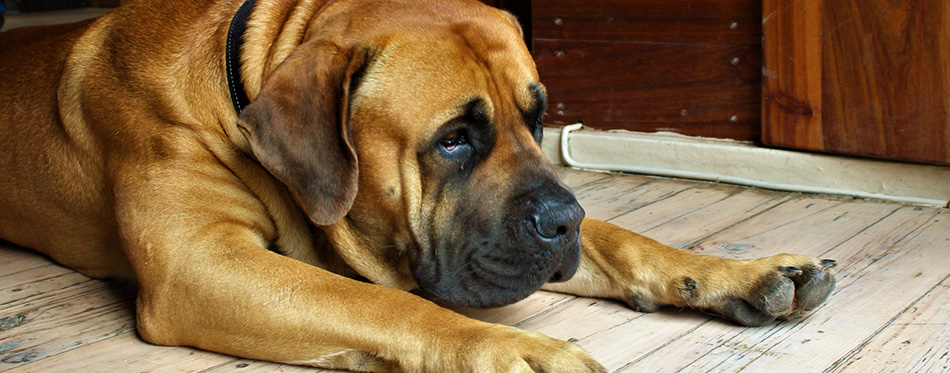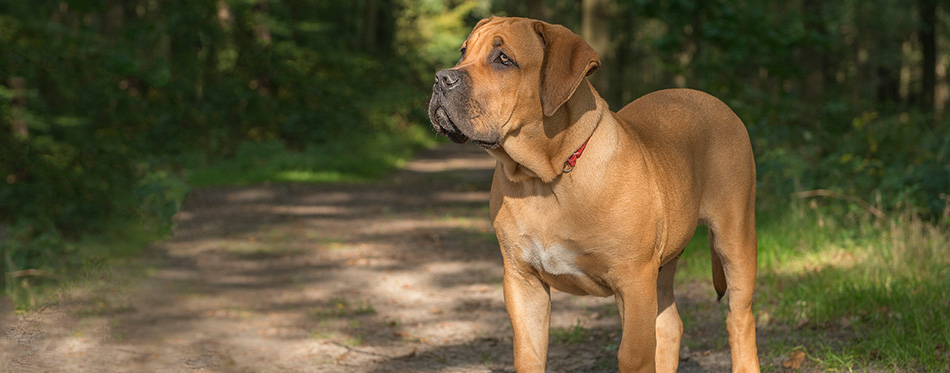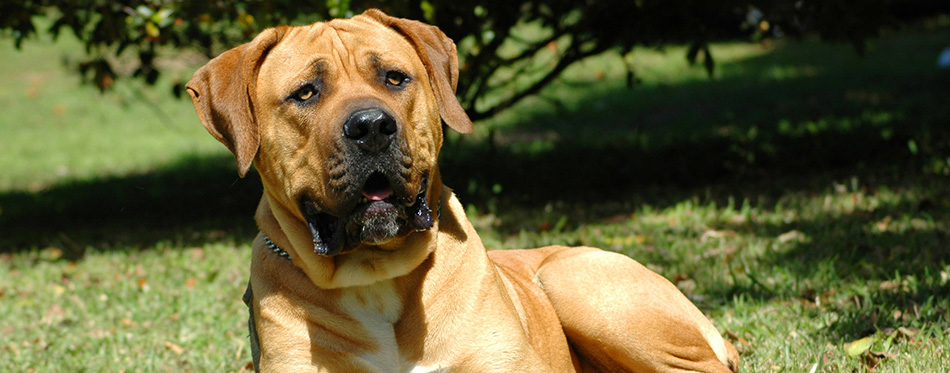The South African Boerboel Mastiff, commonly known simply as the Boerboel is one of the largest modern domestic dogs. The Boerboel has an intimidating appearance which works well for their primary roles as guard dogs. Their blocky heads, wrinkled foreheads, and short muzzles convey a serious attitude which masks their playfulness. In reality, their playfulness can be quite unmatched.
The African Boerboel is quite swift and energetic for its size. Large dogs are usually not active. Its stocky body conceals a ton of muscles putting its weight at a glorious 150 to 200 pounds. And it stands at a height of 27 inches (shoulder height) which gives it a very imposing look. Due to its large frame and high energy levels, the Boerboel is not suited for close living quarters such as apartments. A big enough backyard with a wall and a secured gate would be a perfect arrangement because it needs space to move around and exercise. Besides, the Boerboel may not take kindly to nosey flatmates because of its territorial and protective instinct.
The Boerboel’s normally maintains a calm and watchful disposition which most people mistake for a standoffish attitude, but it would not hesitate to alert its owners of any invasion. With a powerful baritone, its bark is powerful enough to stop a seasoned intruder dead in their tracks. The African Mastiff takes its guard duties very seriously and is very protective of its adored humans. It will go to great lengths to defend its household from any aggressor. That said, African Mastiffs are also very caring. And this quality translates into their devotion towards their work. They are very passionate about their duties and are known to be very loyal.
History of the Boerboels
Boerboel which translates to ‘Farmer’s dog’ in Afrikaan rightly depicts its role as portrayed through history. The history of this working dog is as straightforward as it can be, although the exact breed origin is unknown.
According to some reports, Jan Van Riebeeck brought the Boerboel to South Africa when he established Cape Town. On the other hand, other reports are not specific about the exact person that brought the first Boerboel to South Africa. Instead, it is widely concluded that the mammoth breed was introduced with the arrival of European settlers on the African soil. Modern-day Boerboel Mastiff’s origin has been traced from the North-Eastern Free State, Northern Natal to the Transvaal regions of South Africa. It was traditionally used as guard dogs in these regions.
Many also believe that the popularity of the Boerboel began after the Anglo-Boer War in 1902 when large dogs of the Mastiff family were cross-breed and used as escorts for the European settlers. This notion was further validated when the De Beers Diamond Company used Bullmastiffs as guard dogs to protect their mines from intrusion. These Bullmastiffs were said to have gone on to mate with other native African dogs and Boerboel in the region. These facts place the ancestral lineage of the South African Boerboel as a mixture of African and European breeds which may include the Bullmastiff, Rhodesian Ridgeback and Bulldog.
The African Mastiff are tough working dogs used by the Dutch settlers to protect their farms from predators. There were also used to herd and control farm oxen. After the Europeans left, the locals went on hunting trips with the Boerboel to help hunt small game or carry it back home. Its prey instinct and alertness when outdoors made it an effective tracking tool.
Boerboels were members of the homestead and were treated more as companions than working dogs. They became active baby sitters, guarding children on the farms with a fearless zeal making them an invaluable member of the household.
Quick Facts About the South African Boerboel
The African Boerboel is a loyal, highly intelligent, caring and fearless dog of the Mastiff family. Although it is reasonably independent, the Boerboel still needs a lot of attention from its owners. Leave it outside and alone from the family settings and face a bored destructive giant dog.
- A short tail for greater advantage
Boerboels were initially tasked with guarding and protecting the European settlers against predators. Which means it was normal for it to get in a fight with wild animals whilst executing its duties. In order to provide it with a greater advantage during such fights, the tail of a Boerboel was docked (cut short). Therefore, the opponent could not grab it in a fight or will an undue advantage over it.
- The lion slayer. Truth or myth?
Some of the ‘stories’ surrounding the Boerboel tells of its undeniably strength and power. In one of these folklores, the South African Mastiff fought and killed lions in its quest to protect the farm.
Actually, these lion slayer stories are a teeny-tiny bit exaggerated. Truthfully a Boerboel could take on say a tiger or leopard at best but a lion would be extremely difficult to kill.
- Dark rich melanin
Amongst all the dogs that the Dutch settlers brought to the South African soil, only the strongest could survive in the harsh climate. Not surprisingly, the Boerboel was part of the survivors. As a reward, they were kissed by the African sun resulting in dark skin beneath its fur and belly.
- Color variants to choose from
Apart from the typical brown color, it comes in other colors too. Some of these dogs come in a tawny shade. Other coat color variants include cream, red, brindle, reddish-brown or piebald.
- Jockey with Brains
Don’t get confused at all when your Boerboel executes the perfect escape plan from the yard. This brawn comes with brains as well. And their high intelligence is a plus because it makes it easier to train them.
- They are not without a leader
The African Boerboel is dominant by nature. Therefore, they need a strong firm hand to mold them or they might think they are the leaders of the pack (your family). A strong firm member of the household should establish authority to reinforce who is in charge.
Things You Should Know About the Boerboel Mastiff
Although the Boerboel appears to be a gentle giant, do not be deceived by its calm nature. This dominant breed can be quite aggressive and territorial. If you are a first-time dog owner, I would advise against getting a Boerboel.
Boerboel Health
When a Boerboel is well taken care of and healthy, it could live up to 12 good years. Generally, Boerboels are in good shape and have very few genetic health conditions. However, you should be on the lookout for vaginal hyperplasia (in females), as well as entropion and ectropion (which affects the eyelids). Your Boerboel could also suffer from hip and/or elbow dysplasia.
Recently, stress and metabolic changes in the Boerboel has caused a condition called juvenile epilepsy, which causes seizures in the dog. Be sure to contact your vet immediately you notice any signs of fits or abnormal behavior (restlessness, excessive salivation, head shaking, facial twitches, vomiting, and anxiety) in your dog.
African Boerboel Training
Despite its size, the African Boerboel is relatively easy to train. This intelligent breed needs both physical and mental stimulation exercises to stay in shape. Training should start early with instructions from an experienced dog handler – but as mentioned, first-time dog owners may have to reconsider getting a Boerboel due to their lack of experience.
For the first two months of a puppy’s life, all you need to teach them is how to respond to its name and the word ‘no’. You may also begin house training your pup as it familiarises with its new environment.
Rigorous physical training should start no earlier than 18 months of age. You should also have your dog undergo a complete medical check-up to ascertain its health status. A dog diagnosed with dysplasia should be trained with much more caution to avoid injury to ligaments. Early training before 18 months puts your Boerbooel at risk for dysplasia and strain injuries.
Due to the African Boerboel’s dominant and territorial nature, training sessions should be handled with a firm and strong hand. The trainer must be strict when needed to ensure the dog’s obedience at all times. A slack hand can result in an unsociable, aggressive, gigantic ball of strength, and that nobody wants!
A few things to note during training sessions:
- Give your commands briefly and in a clear firm tone. Use the same words for each command you do not confuse your dog. You should also accompany commands with gestures so your Boer can obey you even without words.
- Always use a calm quiet tone when addressing your dog. A loud voice should be used as a punishment and not regularly. Constantly shouting at your dog would not make it more obedient!
- Reward your dog whenever they obey your directives. A reward can be a treat or praise. An extreme degree of punishment should be a newspaper or a small twig if a raised voice doesn’t cause changed behavior. Never hit your dog with your hand or its leash, it must have complete trust in these two objects at all times.
Related Post: Dog Treats
African Mastiff Exercise
The African Mastiff needs a lot of exercises to stay in shape physically and mentally. A long walk which could also serve as socialization time is recommended daily. Park visits are discouraged especially adult dogs because of their tendency to be aggressive towards other dogs. Pups could use the experience to develop their socialization skills.
Boerboels like challenges and would likely excel in sports such as Rally-O, Weight Pull, Agility, Obedience, Protection, and Stock Work. They are also known to do well in Therapy work too. During warmer months, they may need a little more than persuasion to get in some exercise because they tend to get lazy. Remember a tired dog is a happy dog so be sure to keep your dog busy and occupied at all times. Please, do not let your African Mastiff off its leash in a public place. It’s the best way to avoid a very unpleasant day or a lawsuit.
Don’t forget to include some mental exercises too. Engage your Boerboel in a variety of interactive games (doggy board game). Puzzle toys, learning new tricks, hide and seek are fun ways to stimulate your dog mentally. Having playdates occasionally also serves as a brain booster for your African Mastiff pup. Remember to rotate the games for your dog. Monotonous breeds boredom.
Boerboel Mastiff Nutrition
Talk to your vet for recommendations on high-quality dog food. You could also ask for advice on human foods that are suitable for the Boerboel. Portion control is very important. Especially when your African Mastiff is not getting enough exercise, overfeeding may result in overweight. Treats should also be given in moderation, even though it is an important training aid.
Puppies (3 weeks to 6 months) may be fed 3 times daily. Then twice daily until age 1, where once a day should suffice for it. Needless to say, your Boerboel’s food portion may depend on factors such as health, age, size, reproductive status, and temperament and activity level.
Most importantly, make sure fresh, clean drinking water is available at all times.
For more guides on choosing the right dog food, you may wish to check out our reviews of the best dry dog food, rawhide for dogs, cheap dog food, wet dog food and puppy food.
Boerboel Grooming
The South African Mastiff does not need any special grooming aside the usual methods to keep a dog’s coat shiny and neat. A weekly brushing on its short, dense coat will help remove any debris or loose hairs tangled in its coat. It will also have its coat looking shiny and lush.
A rubber grooming mitt or a soft-bristled brush would do the trick. Or, try using a hound glove for a thorough brushing. Brushing is considered as an essential part of grooming because it distributes skin oils throughout the coat. This keeps the coat healthy as well as stimulate new hair growth.
Their ears should be checked often for signs of infection and debris pile. Gentle regular cleanses with a mild alcohol-free cleanser would be a very good idea. Those teeth and jaws would also enjoy a brush habitually and a good chew on a dental toy.
Its nails should also be trimmed regularly. A Boerboel with long nails will experience pain and will find walking difficult. And don’t forget the baths. A dirty, smelly Boerboel is no fun at all.
For more help on dog grooming, you may wish to read our guides on the best dog nail grinders, dog dryers, dog wipes, dog drying towels and dog shampoo.
South African Boerboel Temperament
Although the Boerboel can be easy-going, it doesn’t warm up to strangers easily. And can get aggressive towards outsiders and other dogs (especially of the same gender). Until you have upper hand over the Boerboel, the dog park may not be a good place to hang out.
They pair great with kids. You couldn’t ask for a better protecting caring canine for the youngsters. The downside? Playdates could become limited as the Boerboel may mistake rough play as a threat on its charge. And this could escalate very quickly if there no adult around for supervision. Please make a note to educate children on how to treat dogs. No poking, tugging or cruelty of any sort as this can trigger an aggressive response.
The South African Mastiff can be a little standoffish especially in a new environment but with time it would become lively and free-spirited.
Summary
The Boerboel is a family pet. It is an even-tempered, affectionate and loyal companion. The no-nonsense look is reserved for strangers so expect a big goofy smile when you are inaugurated into the family. A Boerboel isn’t picky when it comes to which human in the household they would warm up. In fact, they would rather have an armful of doting humans than one devoted human. This makes them excellent family dogs especially in households where the children are not so young. The Boerboel can accidentally knock down a child during play with its tail. Young children need to be supervised by an adult when playing with the dog. Also they tend to drool quite a bit. So be ready for sloppy kisses and wet patches on your couch if your dog uses your living area too.
The African Mastiff is very self-assured, fastidious and fearless. You couldn’t have asked for a better caretaker for your kids. It takes its protective work very seriously so this may even hamper fun playdates with its overly protective behavior.
Raising this dog breed isn’t an easy feat. It will take dedication and formal training to raise them right. Be sure to instil discipline at a very early age to make subsequent training sessions easy. Training is a must. Don’t let its docile nature tell you otherwise. And if you train it right the reward is a gentle, loyal and fearless companion.
You are in charge and not your dog. Establish boundaries as early as possible to prevent a wilful disobedient Boerboel. Make sure your African Mastiff does not boss you around.
Source:
- Boerboel – Native Breed.org




